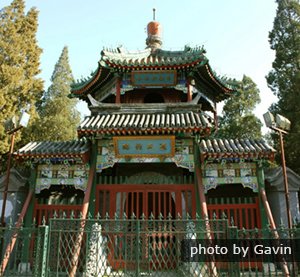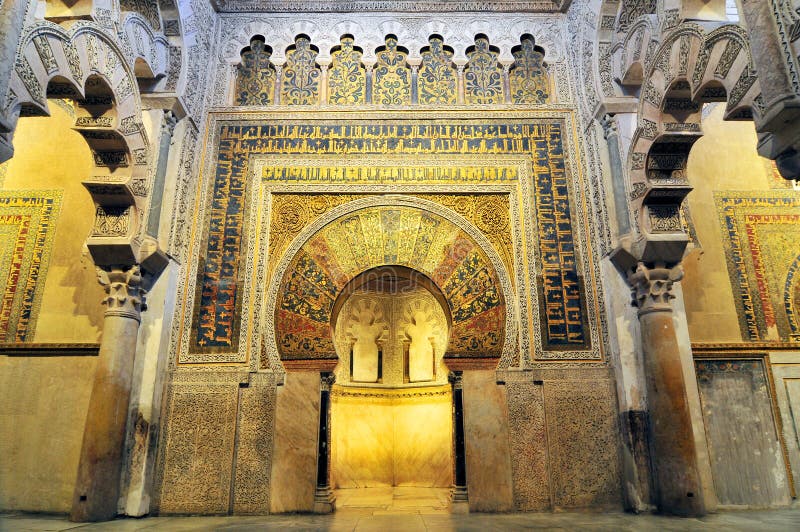
The mihrab of the Niujie Mosque, Beijing, China (北京牛街礼拜寺的米哈拉布)
 Beijing Niujie Mosque
Beijing Niujie Mosque
Andalucia The Moorish Mihrab of the Cordoba Mosque Mihrab Prayer Niche, La Mezquita de Cordoba, Spain.
Islamic art spans around 1400 years, covers a diverse geographic population, and is influenced by many sources. It is important to note that it is not always religious in nature. Because of these factors scholars are often torn about the use of the phrase Islamic Art. Common characteristics include repetitive patterns, lack of figures, stylized forms based on geometry, and a decorative use of calligraphy. It has the ability to transcend time and space. These cohesive aesthetics are what define the art as Islamic, but we should be careful to recognize that individual cultures have shaped the art in the region in which it exists. (1)
The above images are of two mosques located in vastly different geographical regions. You can see the similarities in the use of geometry and repetition, or arabesque. Arches draw the viewer in and there is a pervasive quality that is hard to ignore. They both use calligraphic citation from the Koran in the decoration and there is a lack of figurative presence. However similar these mosques seem at first, there are distinct differences between the two that can be attributed to their locations.
The top two photos are of the Niujie Mosque in Beijing China. It is the oldest mosque in Beijing and the most famous. The external architectural forms are a blend of Islamic and Chinese influence. The structure reflects Chinese architecture in the repeated use of rectilinear forms rather than domes, and there is a distinct regional use of color and ornamentation on both the interior and exterior. It almost looks like a pagoda rather than a mosque and the use of dragons on the ornamentation gives it a distinctly Chinese vibe. (2)
Next, we fly across the globe to Spain and take a look at the Cordoba Mosque located in La Mezquita de Cordoba. This time we have a mosque with a very distinct byzantine influence. This structure has a rich and diverse history where it began as a temple, was transformed into a Church, then converted into a mosque, before being rebuilt by the Umayyads.(3)The architects made use of a number of Roman columns when rebuilding the mosque. The building is made from pieces of the Roman temple that was once occupying its place. The mihrab is an opulent masterpiece heavily influenced by Roman antiquity.
Islamic Art is not limited to a time, place, or culture. It isn't restricted to religion or architecture. We have compared two different mosques from across the globe and found that while they are different they have unifying features. They were each fashioned according to the popular architectural designs of the region, but within we found the tessellating tiles and sacred geometry that defines Islamic Art. It is truly a transcendental experience.
Notes
1. "Introduction to Islamic Art," Lumen Boundless Art History, accessed September 25, 2020, https://courses.lumenlearning.com/boundless-arthistory/chapter/introduction-to-islamic-art/.
2. "The Niujie Mosque," China Highlights, accessed September 25, 2020, https://www.chinahighlights.com/beijing/attraction/the-niujie-mosque.htm.
3. "The Great Mosque of Cordoba," Khan Academy, accessed September 25, 2020, https://www.khanacademy.org/humanities/ap-art-history/early-europe-and-colonial-americas/ap-art-islamic-world-medieval/a/the-great-mosque-of-cordoba



Hello!
ReplyDeleteI really enjoyed your blog post, how you described each individual mosque and the influences of Islamic culture as well as the culture of the countries they reside in. I also really enjoyed the sentence you wrote at the end, how Islamic art isn't limited to time, place, or culture. We really see that when we look across the globe and view the rippling effect that Islamic art has on other cultures. Great post!
Ashley, I haven't done or seen a comparison blog post until yours, and I find it very interesting. Looking at your blog post there is a lot that I don't know about the history of art. They are such beautiful pieces of artwork, so similar but so different.
ReplyDelete